After the departure of Mikel Arteta, there was a big question of who the next assistant manager Pep Guardiola would bring in. The likes of Xavi and Xabi Alonso were thought to be under consideration given the mould Arteta left as a young and aspiring manager having just recently called time on their playing career.
However, this time around, Guardiola called upon one of his mentors, Juan Manuel Lillo, the man who brought the Catalonian manager to Mexico for a six-month spell just to learn under his guidance. Now, Lillo is bringing his tutelage to the assistance of Guardiola in Manchester.
This tactical analysis will break down the effects from Lillo’s arrival we can see in Manchester City’s side already. We will break down the general system and personnel before going into the build-up play and movements in the final third. The last section of the analysis will focus on how these tactics could be particularly effective in the upcoming Champions League knockout stages and specifically against a 4-3-3 system.
System & Personnel
Lillo has spent over 30 years in management. While he has never found great success, he is seen as one of the brightest minds in football. His intense research into football tactics brought him to his patented 4-2-3-1 formation. The reasons behind his adoration for this structure was due to the ability it gave to the players in front of the ball, the three advanced midfielders along with the striker, to be able to get closer to the opposition’s goal with the defensive cover this formation provides. Using this ideology, Lillo used a lot of principles of positional play with these players. The focus of the tactics are allowing the front four to attack the defensive line of the opposition very high, as this was originally designed to break down the typical 4-4-2 structures of Spanish sides in the 1990s.
Since Lillo’s arrival in Manchester, the use of the 4-2-3-1 formation has been used much more frequently. Often used beforehand in matches where Guardiola looked for more defensive cover, it is now used to provide the attack more flexibility.
At the heart of this system, Ílkay Gündogan and Rodri sit at the base of midfield acting as a double pivot. These two interchange and work off each other extremely effectively. As we will discuss later on, they also switch between playing in this initial midfield line and one dropping in between the centre-backs. This protection is also what allows the full-backs to stretch higher up the pitch.
In the attacking third, we have seen a great emphasis on flexibility between the four most-advanced positions. Kevin De Bruyne is the lynchpin of the structure, playing as the central attacking midfielder and moving around the pitch as needed. Raheem Sterling and Phil Foden have been regulars playing as the wide attackers. This is where City are at their deepest, however, with the likes of Riyad Mahrez and Bernardo Silva are equally able to play these positions. Up top, Gabriel Jesus has filled in for the injured Sergio Agüero and played the role of the centre-forward in this system to perfection, dropping in often to link with teammates and open space for runs in behind.
Build-up
In utilising a double-pivot in midfield, Manchester City are allowed to be extremely flexible in their build-up methods. The two players who fit these positions best in Guardiola’s side are Gündogan and Rodri. Both players are equally comfortable playing in different areas of the pitch depending on where they need to fill in and have the passing ranges to push City forward as they build their attacks.
With two players holding in the centre of the pitch, the full-backs push forward to provide the width. This allows the outside midfielders to push in more centrally to link to the striker and assist the advanced central midfielder as play is progressed. With this space the central defenders push to either side of the penalty area to utilise the room in this initial line of the pitch. While this is done in part to add a link between the three players in the very initial build-up – goalkeeper, two centre-backs – this is also effective in opening space for the two midfielders.
With the area directly in front of the goalkeeper open, one of these two holding midfielders has the option in dropping into this spot to form a back-three. This is often only used in circumstances where the opponent is pressing high with two strikers. This alteration allows City to maintain a numerical advantage is such a crucial area of the pitch and move this initial line to create passing lanes into the midfield.

In the image above Rodri has taken up a position between the two centre-backs, with Gündogan maintaining the pivot for the side. As he receives possession he continues to shift it from right to left and moves laterally to Aymeric Laporte.
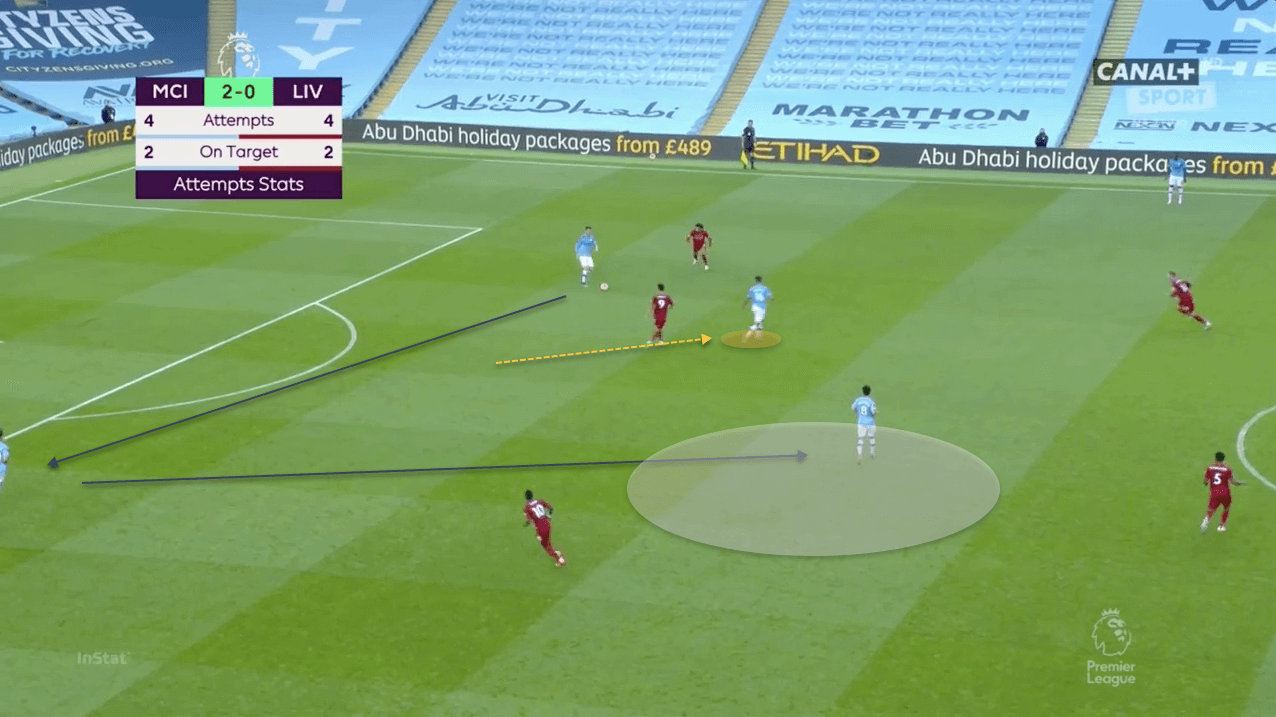
Once he makes the pass, he immediately bursts forward into the midfield. The effects of this movement are seen as Roberto Firmino moves to track his run, which opens up different options. Gündogan can pivot slightly deeper and receive a pass in space, or Laporte can switch it back to Eric Garcia who is now left completely open and would have ample time to find an option up the pitch.
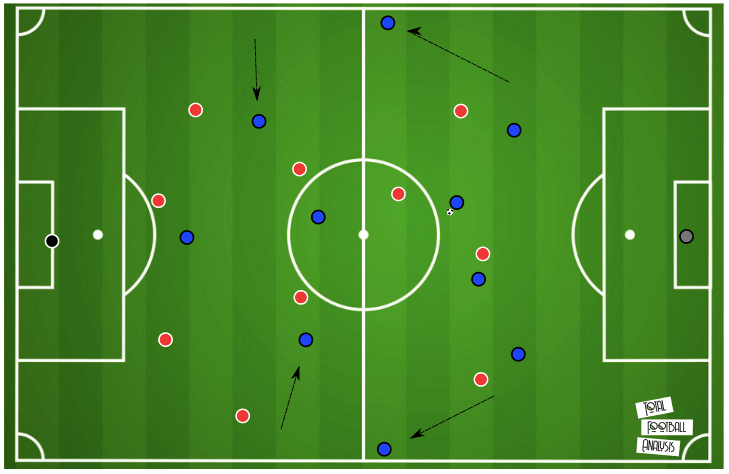
The full-backs’ positioning is also important specifically against a 4-3-3 due to the different match-ups it creates. The centre-backs moving into wider spaces draws the attention of the opponent’s wingers. If they do not press in this area the centre-backs will have all the time to push forward in possession, which the likes of Laporte is happy to do as he looks to take advantage of his brilliant passing range. Likewise, the full-backs of the opposition are put into a difficult spot as if they push too far forward to block this outlet off they risk leaving the channels open. Against City, in particular, this would not be an effective measure and rather a very high risk one due to the passing ability of Ederson.
Therefore, the full-backs are often given space to receive passes and push forward. Benjamin Mendy on the left is a regular outlet due to his ability to find passes in the final third which we will dive further into later on.
Attacking half
As mentioned previously, Manchester City often look to progress into the final third using their full-backs. From these wide positions when they are given space to push forward, the wide attackers position themselves in the half-spaces to provide passing options. When they are found in these areas, the aim is to receive the pass in room to turn and dribble towards the opponent’s defensive line. Here they aim to create 4v4 scenarios against this line, with players looking to make runs in behind, which has a massive impact in allowing the player in possession room to move forward with the ball.
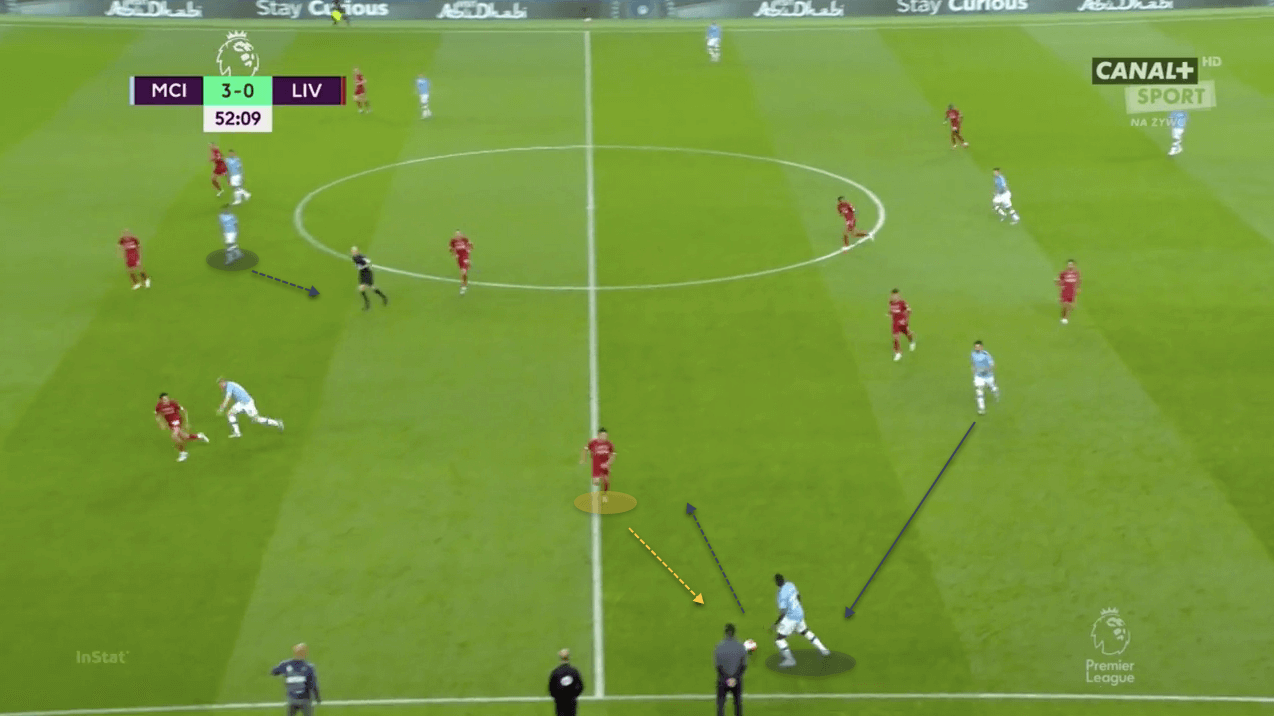
In the image above possession has been moved out wide through Benjamin Mendy. Alex Oxlade-Chamberlain comes out to press the French full-back but is beaten easily. With one midfielder caught out, Jordan Henderson is caught between two minds of pressing the player in possession or dropping to cover the space behind him.
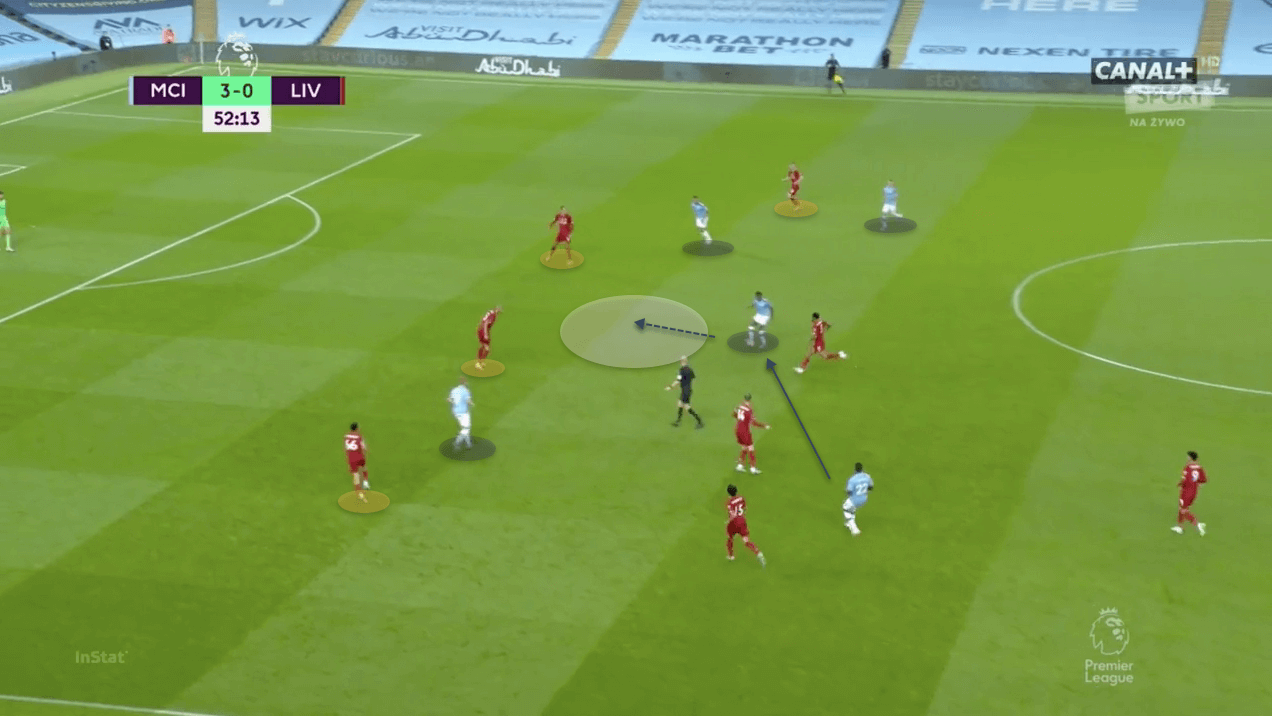
This confusion creates the time for Sterling to position himself in this area for a pass. Mendy finds him and City once more are left with a 4v4 situation against the Liverpool defence.
The second method they use to get into this situation is through the defensive midfielders. With the width being held by the full-backs, the centre-halves push out to cover the space, leaving room in the middle for one of the two in City’s double pivot to drop into this area, with the other sitting directly in front of this now back-three. This holding midfielder scans to identify opportunities to play passes through the midfield line of the opponent and into these advanced attackers, who sit just behind this line to give themselves the most amount of space in front of the defenders.
The striker, most often Gabriel Jesus, also tends to drop into the midfield area to link up play. This gives the other City attackers the opportunity to look and expose space in behind. When the Brazilian moves into the half-spaces, the wide attacker pushes out wide to the touchline on the same horizontal line as the full-back. This drags out the full-back and forces the centre-half into following the striker closer into this area. This gives the opposite-side wide attacker and advanced central midfielder room to attempt to expose this space in the centre.
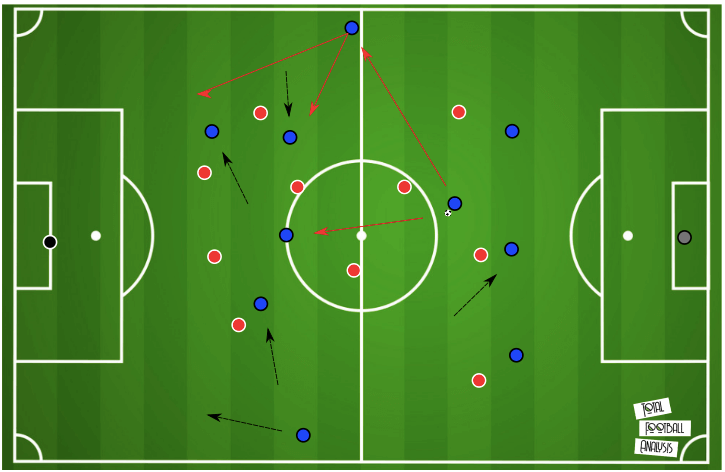
Alternatively, the wide attackers’ movement into the half-space can drag the full-back far enough into this area that opens up the channel for the striker to run into. Gabriel Jesus is very effective in making runs into this area and isolating his centre-back before beating them on the dribble.
City’s shape and typical attacking channels are seen in the image above. The full-backs present a consistent option to change the point of attack and move the defensive block of the opponent. As well, the width they hold allows for City’s front four to create an abundance of movement in the middle of the pitch to open up passing lanes as we see above. A three-man midfield is overrun using this structure with up to five City players occupying this space at times. In the final section, we will detail specifically how Manchester City can use this advantage moving forward.
Advantages against a midfield three
In Manchester City’s match versus Liverpool, we saw the benefits of using a 4-2-2-2 system against a 4-3-3, which could be a tactic used in their Champions League efforts this August. In this section we will take principles from this match and detail how these can be used moving forward.
Using this formation, we have seen the best come out of Foden. Deployed originally on the right or left side, he is given the freedom to move centrally as the second attacking midfielder. The opposite wide attacker, normally Sterling or Mahrez, moves alongside Gabriel Jesus in the front line.
Foden particularly has strived in a position where he is given the freedom to roam from outside to in. His tendencies to move into the centre and half-spaces creates issues for defending teams. The opponent’s full-back whose job it is to mark him has to decide on if they can follow Foden into these areas or try and pass him off to a midfield teammate. However, the latter is difficult due to the numerical emphasis City places on the midfield. With all four of the most advanced attacking players drifting into this area, the midfielders are overrun, which is how City craft a vast amount of their opportunities.
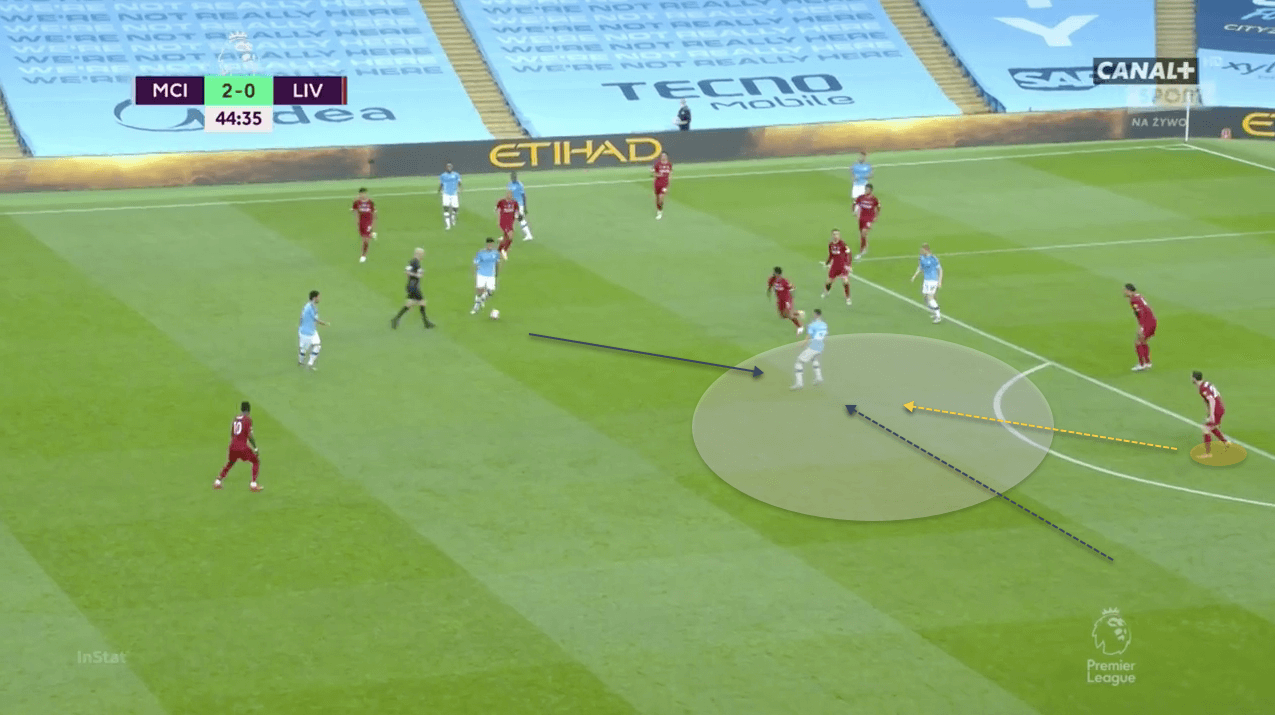
Foden’s agility allows him to work in tight spaces and move into space extremely quickly, typically from inside back to outside. In the image above Foden is in the central area as we have discussed. This creates a decision for Andrew Robertson to make, between letting Foden receive possession unmarked in front of his centre-backs, or track him into this deeper area leaving Liverpool’s left side exposed. In this instance, the left-back picks the latter and pushes out of his defensive line.
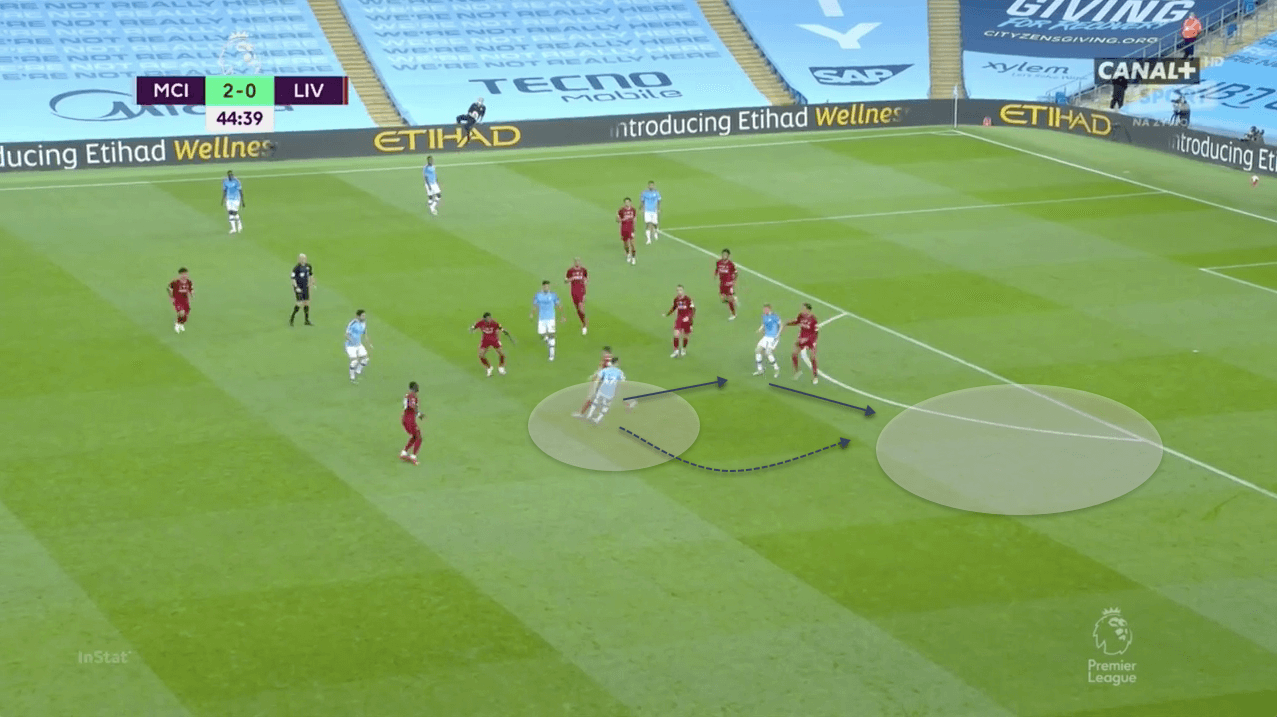
Foden recognises the press and makes a quick pass into De Bruyne who has shifted forward into the centre-forward role after Gabriel Jesus dropped into a deeper position on the left as it moved from this side to the right with Foden. The English youngster cuts outside quickly as Robertson is still moving inside to cover and opens up for a return pass. Foden is now in on goal and puts City 3-0 up.
City’s success in this match came from their numerical superiorities in midfield duels. With two midfielders on either side of Liverpool’s midfield, it forced Liverpool’s midfield to become stretched. Sending two of the three midfielders for Liverpool to press City’s double pivot, this left the two advanced midfielders in a 2v1 advantage against the lone pivot for Liverpool. Using the wide outlets we discussed earlier let City move around the press and find their attacking players in behind where they had Liverpool’s defensive players outnumbered.
Alternatively, if Liverpool kept two midfielders deep and only pushed one forward, it gave Rodri and Gündogan too much space to be able to pick a pass between the lines or in behind through the channels or half-spaces. A lack of press allowed City to dominate proceedings and kept Liverpool trapped deeper in their half.
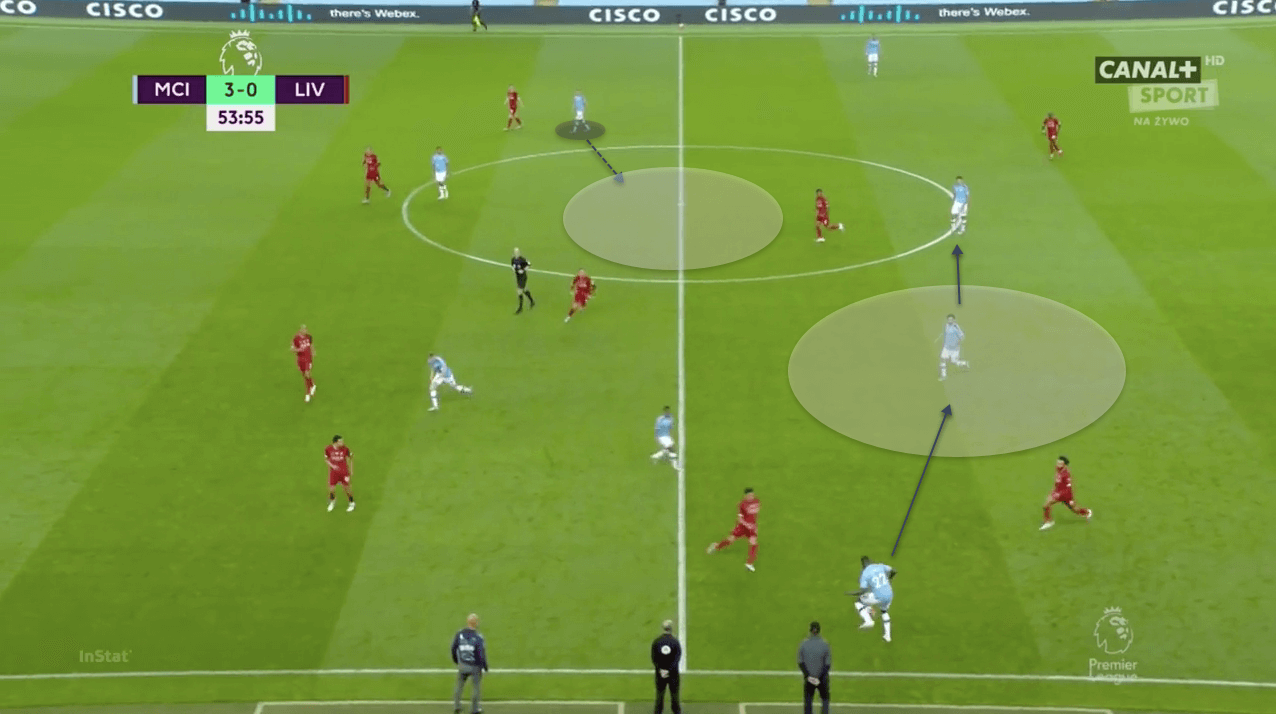
In this example, we see various principles we have discussed thus far. Possession has been moved to the left side into Mendy who holds the width. As he scans for options, Gündogan makes himself available for a horizontal pass into the centre of the pitch. The German quickly continues to switch the point of attack and moves it once more into Rodri alongside him.
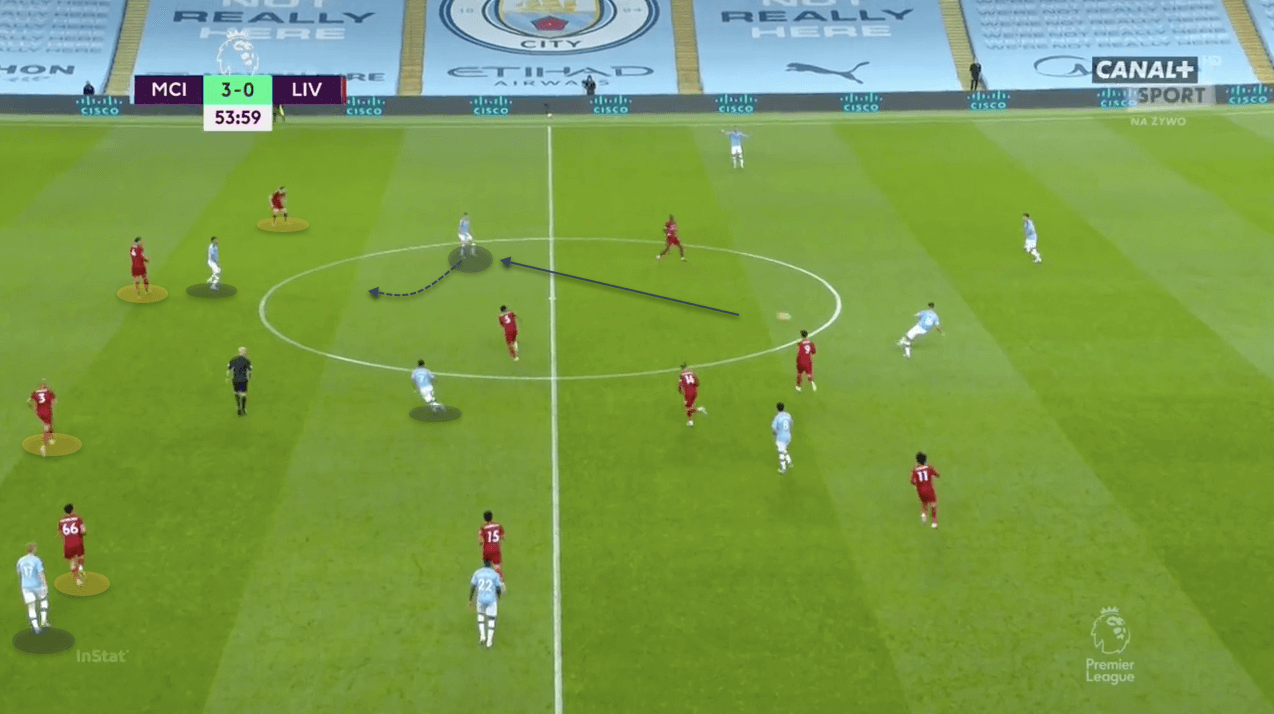
On the right side, Foden anticipated this switch of play and moved from the wing into the half-space in behind the Liverpool midfield. His positioning allows him to receive the pass from Rodri and turn to run at the defensive line. Liverpool are caught out as Oxlade-Chamberlain moved wide to press Mendy and was too far advanced along with Henderson. Gini Wijnaldum is the last midfield player to cover Sterling as he occupied the centre space, but once Foden moved into this area the Dutch midfielder was caught unprotected.
Conclusion
While Lillo’s time at Manchester City is still in the initial stages, his impact on the ideas and tactics used by the side are already evident. The flexibility of the positional play in City’s new 4-2-3-1 has given them a new dynamic as Guardiola aims to deliver the last major honour the Manchester club has yet to achieve.
This year’s UEFA Champions League knockout stages offer a much different task than in normal years. After a long and frustrating season, City look to be in a promising position entering this World Cup-style tournament, however. With players returning from injuries, Guardiola has his side fit and firing. With the personnel at hand, the new tactics influenced by Lillo could have a major say in their European chances, as the 4-3-3 will be a common formation they play against. Using similar structures to those in the match against Liverpool could be the difference in these big matches to come.

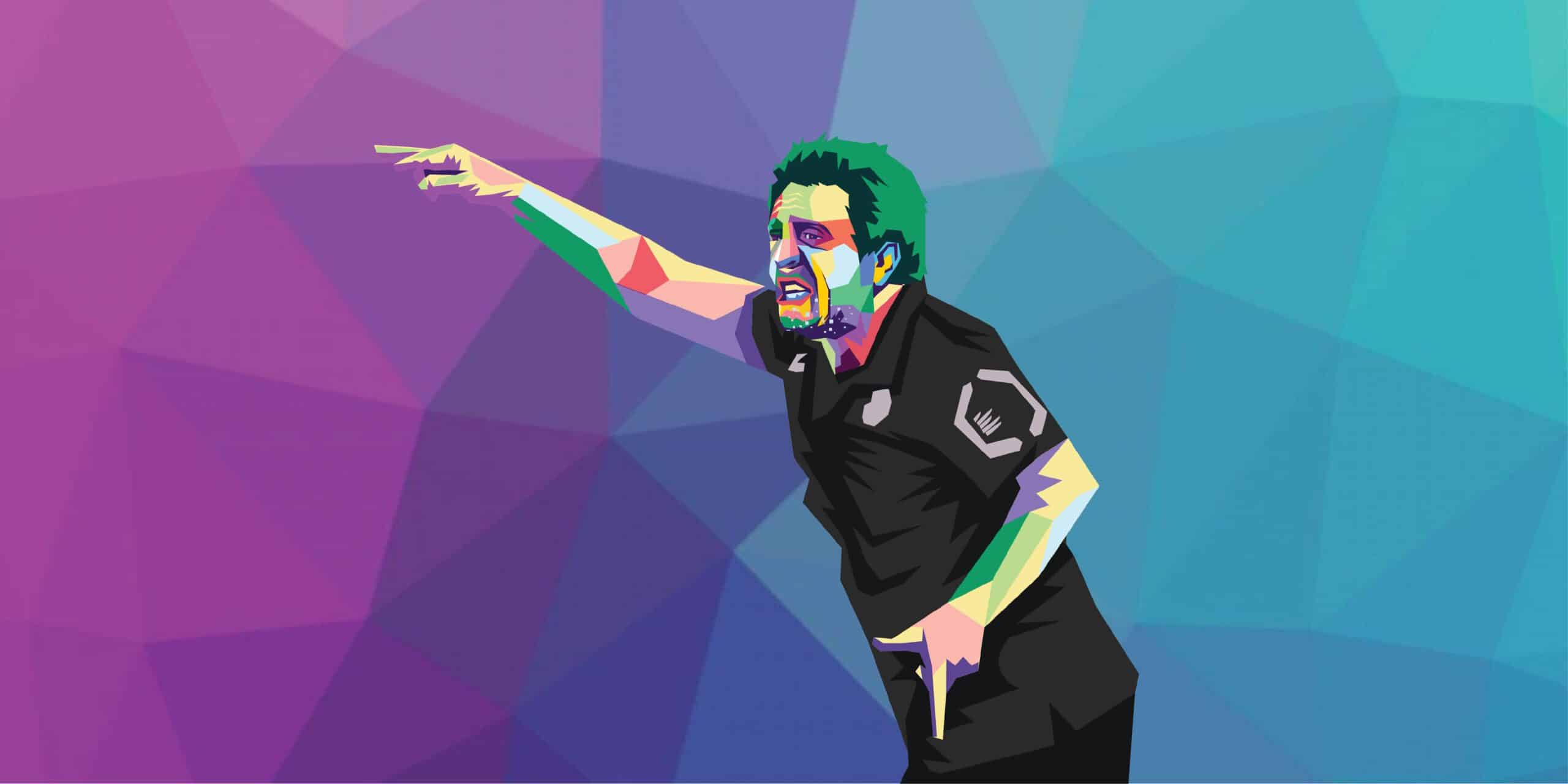




Comments